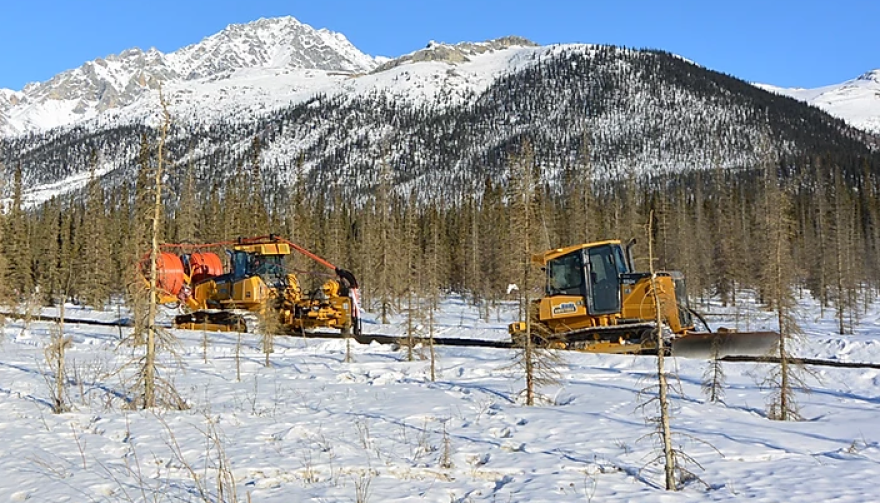A Palmer-based telecommunications company has nearly completed a 300-mile-long fiber-optic cable network called AlCan ONE that stretches from North Pole to the border. From there, it’ll connect up with a new Canadian fiber-optic cable and become Alaska’s first all-terrestrial connection to the World Wide Web. And along the way, it’ll bring high-speed broadband to outlying Alaskan communities that until now have only had limited internet service.
Matanuska Telephone Association CEO Michael Burke says after a couple of months of hiatus, crews are back at work on the AlCan ONE fiber-optic cable project now that the ground in swampy areas along the route is good and frozen – as required by federal regulations.
“The Army Corps of Engineers permit that we had for some wetland areas said you had to wait until the ground froze before you could go work in that particular area,” he said.
A company subsidiary called MTA Fiber Holdings, which is running the project, hired Palmer-based contractor Alaska Directional to lay the cable. Burke said in an interview last week that Alaska Directional finished most of the job by November. But he says the company had to wait ’til late December, after the first real cold temperatures had set in, before going back to work in areas like Shaw Creek Flats, a wetland about 20 miles north of Delta Junction.
“So we’re just finishing up the little bit that needed to be done in those areas,” he said, “finishing up some fiber-splicing and pulling fiber into the conduit.”
Burke says the new cable is connected to an older Fairbanks-area fiber network built years ago by a Golden Valley Electric Association subsidiary called AlasConnect. He says MTA bought AlasConnect four years ago, and then linked its network with a new fiber-optic cable running from Healy, which had been at the northernmost reach of MTA’s service area.
“So really this project is kind of an extension off of what we already owned and had in place,” he added.

Burke says once Alaska Directional completes work on the AlCan ONE, it’ll link up a network being built by Northwestel, a Canadian telecom. A Northwestel spokesman said last week the company has almost finished installing the 200-mile-long fiber-optic cable from Haines Junction to the border. And Burke says MTA will link up once the Canadian fiber’s connectivity is tested.
“We’re just waiting for the final test results from them on their side of the network, which they anticipate having here pretty quick,” he said.
When AlCan ONE becomes operational this spring, it’ll be the only terrestrial fiber-optic cable linking Alaska to the World Wide Web. The other four cables run under the ocean floor from the Pacific Northwest. Burke says the overland cable will be more secure and reliable, and less-expensive and easier to maintain than a subsea cable.
“I think each one of those four cables that are out there probably each cost over a $100 million,” he said. “and we’re definitely spending a lot less than that.”
Burke won’t disclose the cost of the AlCan ONE project, but he says MTA Holdings will save many millions of dollars annually, because it will no longer have to pay other telecoms like Alaska Communications for access to their big internet backbones.
“That’s really the big benefit for us,” he said.
Burke says the AlCan ONE network will have enormous data capacity – up to 100 terabits per second, initially, which he says is more than enough to meet all of Alaska’s internet demand. He says that excess capacity will enable MTA to sell bandwidth to smaller telecoms that provide internet service to communities along the route.
“So, Harding Lake, Delta Junction, Tok, Dot Lake, Northway and at the border itself, we’re in the process of installing equipment there,” he said.

That’s good news to residents of those communities, who’ve had to make do with at best, DSL connections, that often are slow, balky and very expensive. That’s why many Tok-area residents said during a community meeting last fall in Tok that they were very interested to hear about internet service that the area’s main utility, Alaska Power and Telephone, wants to provide once the AlCan ONE network is up and running.
“This project, we’re hopeful, will provide much greater capacity,” AP&T CEO Michael Garrett told people at the Aug. 12 meeting at Tok's Visitor Information Center. “But we’re also hoping that that price will help us in providing broadband services.”
Garrett said the company wants to offer 10 megabits-per-second downloads and 1Mbps uploads, with 250-gigabyte capacity, for about $80 a month. He says that’s about what AP&T customers now pay for less than half of that download speed and a fifth of the capacity limit.



